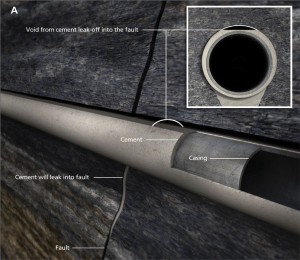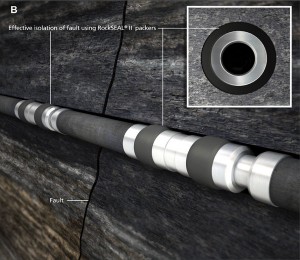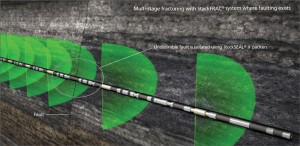Open-hole packers may help isolate faults in multistage fracturing tight formations
Characteristics of shale, tight carbonate formations may require drilling changes to achieve effective isolation in horizontal wells
By Dan Themig, Packers Plus Energy Services

Drilling and completion operations in faulted reservoirs present a unique set of challenges. With the advent of multistage fracturing and multistage acidizing, the requirements for drilling methodology in reservoirs that contain faults or major fractures have changed. Additional considerations must be made for horizontal wells in faulted reservoirs as they behave differently than vertical wells. Understanding the shortfalls of certain methodologies, as well as the challenges of drilling in these reservoirs, is key to success.
Faulted Reservoirs
The location of a fault in tight reservoirs may have both positive and negative implications. If the fault is connected to a series of natural fractures, then it can become the most productive segment of the well. We have seen applications where drilling across a single fault has produced a more prolific producing well than a standard multistage fractured well in a similar area of the field without faults.
Conversely, the fault may connect to water or may become a sinkhole for the stimulation fluids used on all of the stages during hydraulic fracturing.
In the past, faults were generally considered favorable unless connected to water. Stimulation of the faulted area was quite easy. It typically involved removing drilling damage caused by mud and filter cakes. Once these were removed, the wells produced easily, whether horizontal or vertical.
Because today’s target formations are tighter, the challenges are quite different. Not only do we need to provide prolific initial productivity – something you might see out of a single fault – but more importantly, we need to effectively drain all of the rock in the targeted area, which usually requires multistage fracturing.
Drilling Challenges

Drilling horizontal wells in faulted reservoirs can be challenging. In particular, the specific location of faults is nearly always in question. When drilling a horizontal well, the chance of crossing one or more faults becomes very high. Sudden fluid loss after drilling through a fault or fracture can be difficult from a well control standpoint and can cause issues such as differential sticking of the drillstring.
In the past, nearly any practice was acceptable to rectify differential sticking; as long as the drill pipe released, drilling could resume. In tighter reservoirs, there are secondary objectives, such as maintaining hole integrity due to the requirement for multistage fracturing.
In one particular case, the common practice for releasing differential sticking was to pump significant volumes of hydrochloric acid to get the drill pipe to release. This process has been an acceptable drilling procedure for years. However, the operator is now drilling on the flanks of the field, and these wells require significant stimulation along the entire horizontal. Spotting acid is no longer an acceptable method to resolve differential sticking because the evolution in completion practices requires wellbore integrity.
After spotting significant volumes of acid, it is nearly impossible to establish isolation in the horizontal well to perform multistage fracturing operations because the borehole becomes significantly enlarged when the acid is pumped (Figure 1). Now the preferred process to release stuck pipe is to spot fluids with high lubricity and change the hydrostatic pressure by lightening the mud weight.
The requirement for multistage fracturing is driving change toward finding different solutions to drilling problems. Drillers may need to deal with sticking, maintaining hole integrity, reducing dogleg severity and controlling build radius. In addition, more attention must be paid to hole preparation for multistage fracturing in that a reamer run is usually required immediately prior to installing a multistage fracturing system.
Completion Challenges

In the past, the objective of drilling may have been to cross as many faults as possible, thereby increasing the potential productivity of the well. Intersecting faults in tight reservoirs may still be a desirable objective in shales and tight reservoirs. However, this practice alone may still leave the majority of the reservoir unproductive because it is not effectively stimulated.
It is clear that multistage fracturing and effective isolation during stimulation is now a key objective in shale and tight carbonate formations in faulted areas. In addition, effective isolation over the long term for issues such as water shut-off may be an important consideration.
Historically, cement was used to provide isolation between intervals. In vertical wells with faulting, this is fairly straightforward. The cement top may fall back or void spaces may be created in the annulus, but it is possible to squeeze these voids in the cement in an economic fashion. However, in horizontal wells with faulting, leak-off during the cementing operation or while the cement is setting up can be detrimental or even catastrophic to establishing isolation.
Now that the casing is lying horizontal, any significant leak-off (to a fault or fracture) after the cement is placed can create a void space at the top of the borehole that can extend for hundreds or even thousands of feet (Figure 2a). This void space can make it difficult or impossible to perform multistage fracturing because, once the fracture fluid is in the annulus, it will travel along the borehole and join a fracture from a previous stage.
Through microseismic data, we have seen instances where the fracture did not propagate at the perforations but instead traveled hundreds of feet down the wellbore (apparently through the annulus), where the fracture initiated and propagated. To make matters even worse, if a fault exists, it is likely that numerous fracture treatments will move one by one down the casing annulus and restimulate the same fault or major fracture.
Long-term use of cemented casing in faulted reservoirs with failed cement jobs are cost-prohibitive due to the multiple cement squeeze jobs required to repair them. Future water shut-off or enhanced recovery operations, such as waterflood and CO2 injection, may prove unfeasible or even impossible.
Studies have shown that refracturing can be an effective practice in tight reservoirs over long periods of time. In some cases, refracturing has been done three to four times during the life of a vertical producing well. Faulted wells with poor cement jobs will make restimulation of specific intervals nearly impossible.
Open-hole Versus Cemented Completions
How can these above completion issues in faulted reservoirs be addressed? One key answer is effective isolation along the horizontal wellbore. Historically, the way to achieve this was cementing; however, issues with cement fallback are much more common than previously thought. Although we typically do not know where faulting will occur as the well is drilled, ample evidence is acquired during drilling to indicate when a fault has been crossed. By knowing the precise location of faults, further issues can be mitigated through the completion design.
For example, faults can be blanked off by placing packers on either side of the fault location (Figure 2b). Through experience, we have found that hydraulic-set mechanical packers can provide extremely high differential pressure ratings (in excess of 10,000 psi) in a variety of downhole environments. These appear to be the only packers installed in an open-hole environment that will hold high differential pressures over the long term.
In some areas of North Dakota, open-hole multistage (StackFRAC) systems, dual-element, hydraulic-set (RockSEAL II) packers have isolated water-bearing faults for more than 10 years at pressures in excess of 4,000 psi and 300°F. Therefore, they provide an excellent alternative to cement for both short-term isolation required in multistage stimulation, as well as long-term isolation for water shut-off, secondary recovery and refracturing operations.
The ability to locate a fault during drilling and effectively isolate that fault to either shut it off or provide appropriate stimulation injection, both to the fault and more importantly to the tighter segments of the rock, has emerged as a better solution in shale and other tight formations.
Barnett Case Study

In one area of the Barnett Shale play in Texas, faulting is a common issue. In some cases, faults will be initially productive. Recovery issues, however, dictate that multistage fracturing using slick water and sand is required to effectively drain this area of the field. After evaluating the option of cementing, the operator initially decided that it was the best methodology to use.
However, upon review of these wells, they determined that stimulation treatments in the vicinity of a fault or natural fracture all went into the same area. In some cases, it was believed that as many as four fracture treatments were lost to faults, which not only wasted those treatments but failed to stimulate the adjoining tight rock. The problem was attributed to cement leak-off into the naturally occurring fractures and faults.
The decision was made to change from cemented to a non-cemented liner and open-hole mechanical packers. During drilling, faults and major fractures were identified based on drilling breaks, gas shows and lost circulation. Placement of the packers as isolation points in the horizontal was determined based on where the natural fractures and the faults in the horizontal well were located (Figure 3).
Post-completion results showed that, for the first time in this area of the field, faults in the well had effectively been isolated to allow successful multistage fracturing. Higher productivity, significantly better decline curves and longer-term productivity were observed. In addition, an unexpected result was that water cuts were significantly reduced because the faults were not overstimulated into deeper water-bearing formations.
The completion method for this part of the Barnett was changed to incorporate open-hole packers and ball-activated ports as the primary multistage fracturing completion and operation.
Trawick Field Case Study
The Trawick field in East Texas contains a carbonate formation called the James Lime. It is a relatively tight carbonate reservoir that contains primarily gas and associated produced liquids. Historically, the operator used acid and water fracturing operations to stimulate these wells. The advent of horizontal drilling in the Trawick field presented a new set of challenges. The initial approach to fracturing the horizontal wells consisted of installing a preperforated, uncemented liner in the horizontal well. The liner provided wellbore integrity and the ability to place stimulation fluids effectively.
The method of diversion used was pumping ball sealers during the treatment to distribute the stimulation fluid. This approach did not provide mechanical diversion along the annulus. Because major faults/fractures were commonly located in the horizontal, once the fault was contacted by acid, all the stimulation fluids pumped there. This happened regardless of where the fluids exited the liner because they would travel along the annulus into the fault/fracture.
The net result was a highly stimulated fault. It was also determined that once a fault broke down in the presence of acid, no actual fracturing took place anywhere else along the horizontal.
The tight rock (not the fault) was the best candidate for massive stimulation because it contained the largest percentage of the reserves and required a high contact area to drain. Establishing mechanical diversion was determined to be essential. Cement was ruled out because it was viewed that cementing off natural fractures would greatly decrease productivity. Instead, open-hole mechanical packers were chosen. Installations were done during a two-year program in this field. Mechanical packer placement was determined by the location of faults/fractures crossed during the drilling operation.
Unlike shale, where the faults were isolated from stimulation (Figure 3), in the carbonate formation both the tight rock and areas with fault/fractures were stimulated. Stimulation jobs were strategically designed to produce long hydraulic fractures in the tight rock using slick water and high pumping rates, and areas with natural fractures or faults were stimulated with smaller volumes of acid and water to remove drilling mud and drilling damage.
Open-hole, multistage fracturing systems with mechanical packers were run in this field on more than 30 wells. First, the verification of effective mechanical diversion was immediately evident. Intervals commonly exhibited distinctly different stimulation pressure charts as each interval was stimulated individually. Second, it was determined that the issue with faults and large fractures thieving fracture fluid from other segments of the horizontal was no longer happening. This methodology was used for two years on the drilling project in the Trawick field. Once it was determined that effective isolation of faults and major natural fractures could be achieved, the design of the stimulation treatments evolved, including a combination of both acid and sand fracturing.
The net result was a two- to four-fold improvement on initial productivity on a per-well basis. The cumulative productivity of the project doubled as a result.
Key Findings
- Faults and natural fractures in shales and tight reservoirs can be both beneficial and detrimental.
- Cement is unreliable at establishing diversion and isolation in faulted reservoirs.
- Open-hole packers have proven reliable at isolating faults both for stimulation and long-term production.
- In higher-pressure applications, mechanical packers provide excellent long-term isolation.
- Open-hole completions in faulted or fractured reservoirs provides the benefit of maintaining conductivity of natural fractures.
Conclusions
Unique considerations in tight reservoirs requiring multistage fracturing may also require changes in current drilling practices. Cement, historically viewed as a good isolation media, may not be the correct choice in horizontal wells with faults or fractures. Significant success has been achieved using mechanical, open-hole packers as a replacement for cement to establish diversion and isolation. Productivity and ultimate recovery have been significantly enhanced due to the flexibility of the stimulation process as well as the non-damaging nature of open-hole completions.
StackFRAC and RockSEAL are registered trademarks of Packers Plus Energy Services.





Nice stuff something new to learn